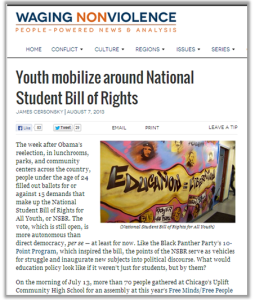Nonviolence Currents – Bridging Nonviolence and Current Events in the Classroom
A service of the Metta Center for Nonviolence
LESSON PLAN #8
Waging Nonviolence Article: Youth mobilize around National Student Bill of Rights

Author: James Cersonsky
Target age group: Ages 14 & up
Themes: Rights, student activism, democracy, citizenship
Subject areas: Civics, Government
Download a printable Word version of this lesson plan here
Pre-reading discussion:
-
What are rights? What different kinds of rights are you aware of (civil, human, animal, earth, etc.)? What are the differences between those rights? Who gets these rights? Who is responsible for upholding these rights?
-
What kind of rights do you have as a student? As a citizen of the United States? As a child (under 18)?
-
It is said that Gandhi, when asked to sign a declaration of rights said, “show me a declaration of responsibilities and I would sign that.” What are the differences between rights and responsibilities? What is the relationship between them?
Reading: Set aside time in class to read the article (10-15 minutes) or assign the reading for homework the night before class.
Post-reading discussion and activities:
-
Have students read the National Student Bill of Rights. Then have them decide on if they agree to this bill and offer suggestions for any changes they would make
-
Return to the author’s question, “What would education policy look like if it weren’t just for students, but by them?” Have students break into small groups and imagine that they are educational policy makers, and have them draft a policy plan. One option would be to have students break into groups focusing on local, state, and national levels.
-
Have students compare the NSBR to another rights document (such as the US Bill of Rights, the Universal Declaration of Human Rights, or the Convention on the Rights of the Child; you can choose one and have the whole class look at that rights document, or break them into small groups and have each group focus on a comparison with a different document). What similarities and differences do you notice?
-
As a class, create a Declaration of Human Responsibilities, include responsibilities to one another, nature and creatures.
-
In what ways might your lifestyle, personal choices impinge on the rights of others around the world? Tell specific stories, e.g. technology, clothing, food choices, etc. What might you do to be more aware of the rights of others? (See True Price Activity below).
-
In what ways does your government impinge on the rights of others around the world? Find specific case examples. What kind of action can you take, beyond just listing rights, to improve their record?
-
Imagining the future: in small groups, have students envision their ideal learning situation. Have them answer the questions:
-What would your ideal school look like?
– What would you learn?
– How would you learn it?
– How would you be evaluated?
– Who would be teaching?
– What rights would you have as a student? How would you exercise those rights and responsibilities?
Additional activities:
Read and discuss the Earth Charter in your classroom.
Try the activity Taking the Human Rights Temperature of Your School from the Human Rights Resource Center.
Follow-up Activity: True Price- Rights & Responsibilities
Note: This activity is an adaptation of one that first appeared in our Nonviolence Currents #2 and was inspired by a TED talk by Zoe Weil, The World Becomes What You Teach. As preparation for the activity, you may want to have students watch the TED talk, and read Zoe’s blog post about the True Price activity.
1. In small groups or individually, ask students to choose an item of clothing they are wearing that they will focus on for this activity. Try to be as specific as possible (material, brand, etc. (Note: You may wish to analyze one item as a class, so that students understand the process, and then have them work on it in groups or individually). As an alternative to clothing, you could also have students do this with an item of food that they ate that day.
2. Have students address the first question Zoe Weil poses: What are the effects, both positive and negative, of this item on you, other people, animals, and the environment? (See sample table below). Students can brainstorm, and if possible, do internet research to find out more specific information about the country of origin (wages, workers rights, environment, etc). Specifically, have them consider:
-
How might this item may affect others’ rights (consider human rights, animal rights, earth rights etc.)?
-
What responsibilities do you have to the people, animals, and aspects of nature that are affected by this product?
3. Next, address the question of alternatives: What alternatives would do the most good and the least harm to you, other people, animals, and the environment? (Make sure that students consider the alternative of not purchasing a new item!). What alternative choice can you make that would least impinge on others’ rights? What alternative would be the most responsible with respect to your own rights and those of others?
4. Invite students to experiment with this exercise the next time they make a choice.
Lesson plan created and developed by Stephanie Van Hook and Stephanie Knox Cubbon of the Metta Center for Nonviolence.
If you have any questions about this lesson, or if you use it and would like to tell us about it, please write to use at education@mettacenter.org. We would love to hear from you!








